[1985-1986] SLR(R) 503 - Woh Hup (Pte) - Singapore Law
[1985-1986] SLR(R) 503 - Woh Hup (Pte) - Singapore Law
[1985-1986] SLR(R) 503 - Woh Hup (Pte) - Singapore Law
Create successful ePaper yourself
Turn your PDF publications into a flip-book with our unique Google optimized e-Paper software.
[<strong>1985</strong>–<strong>1986</strong>] <strong>SLR</strong>(R) SINGAPORE LAW REPORTS (REISSUE) <strong>503</strong><strong>Woh</strong> <strong>Hup</strong> (<strong>Pte</strong>) Ltd and anothervTurner (East Asia) <strong>Pte</strong> Ltd[<strong>1986</strong>] SGHC 3High Court — Suit No 3599 of <strong>1985</strong>FAChuaJ14 January <strong>1986</strong>Arbitration — Stay of court proceedings — Defendant applying for stay ofproceedings on basis that contract contained arbitration clause — Defendant residentwithin jurisdiction — Whether stay should be granted on condition that defendantprovide security — Whether Court has power to impose conditions when grantingstay of proceedings under s 7 Arbitration Act (Cap 16, 1970 Rev Ed)Civil Procedure — Summary judgment — Claim by subcontractor against maincontractor for sums outstanding on subcontract — Whether value of subcontractor’soutstanding claims sufficiently established — Order 14 r 1 The Rules of the SupremeCourt 1970FactsThe defendant (“Turner”) was appointed the main contractor for a development(“the Gateway Project”), and subcontracted some of the works on the GatewayProject (“the subcontract”) to the plaintiffs (“<strong>Woh</strong> <strong>Hup</strong>”). The subcontractbetween Turner and <strong>Woh</strong> <strong>Hup</strong> was terminated after Turner’s employmentunder the main contract was determined. Under cl 21 of the subcontract, uponthe determination of the main contract, <strong>Woh</strong> <strong>Hup</strong> would be entitled to be paidthe value of the subcontract works completed at the date of such determination,calculated according to cl 10. These three appeals arose out of claims brought by<strong>Woh</strong> <strong>Hup</strong> against Turner for outstanding sums due under the subcontracttotalling some $23m.<strong>Woh</strong> <strong>Hup</strong> initially applied for summary judgment against Turner under O 14 r 1of The Rules of the Supreme Court 1970 (“the Rules”). <strong>Woh</strong> <strong>Hup</strong>’s applicationfor summary judgment only related to two out of their four heads of claimsagainst Turner (“heads (i) and (ii)”). <strong>Woh</strong> <strong>Hup</strong> was prepared to refer the othertwo heads of claims against Turner (“heads (iii) and (iv)”) to arbitrationprovided that Turner furnished adequate security. Turner opposed <strong>Woh</strong> <strong>Hup</strong>’sapplication for summary judgment and instead sought an order that all furtherproceedings be stayed pursuant to s 7 of the Arbitration Act (Cap 16, 1970 RevEd) (“the Act”). According to Turner, the parties had, by the subcontract, agreedto refer the present dispute to arbitration.Both applications were heard by a senior assistant registrar (“the SAR”). TheSAR made no order on <strong>Woh</strong> <strong>Hup</strong>’s application for summary judgment. Asregards Turner’s application for a stay, the SAR ordered that all furtherproceedings be stayed pursuant to s 7 of the Act on condition that Turner shouldfurnish security in the form of a banker’s guarantee, and that judgment beentered in <strong>Woh</strong> <strong>Hup</strong>’s favour in default thereof. <strong>Woh</strong> <strong>Hup</strong> appealed against the
506 SINGAPORE LAW REPORTS (REISSUE) [<strong>1985</strong>–<strong>1986</strong>] <strong>SLR</strong>(R)Arbitration Act (Cap 16, 1970 Rev Ed), the plaintiffs and the defendantshaving by the subcontract agreed to refer to arbitration the matter inrespect of which this action is brought, and for costs.6 The two applications were heard together by the senior assistantregistrar and, after two days of hearing, on 20 August <strong>1985</strong>, he made noorder on the application of the plaintiffs for summary judgment under O 14r 1, and on the application of the defendants he ordered that all furtherproceedings in this action be stayed pursuant to s 7 of the Arbitration Acton condition that the defendants furnish within 30 days from 20 August<strong>1985</strong>, security in the form of a banker’s guarantee for the sum of $7.5m, indefault thereof judgment be entered for the plaintiffs in that sum and thatthe costs of and occasioned by the action be reserved with liberty to theparties to restore the application.7 The plaintiffs now appeal against both orders and the defendantsappeal against the condition in the second order.Application under O 14 r 18 The plaintiffs say that their claim for summary judgment totalling$23,150,331 is made up as follows:(a) a sum of $1,822,724 which is the amount included in certificatenumber 18 issued by the architects dated 14 December 1984;(b) a sum of $2,696,457 which is the amount included in certificatenumber 19 issued by the architects dated 15 January <strong>1985</strong>;(c) a sum of $2,007,012 due under their payment applicationnumber 20; and(d) a sum of $16,624,138 due as costs of materials or goods properlyordered for the subcontract works.9 The plaintiffs ask for summary judgment in respect of the claimsunder (a) and (b). The plaintiffs are now prepared to have the claim under(c) referred to arbitration on condition that sufficient security is ordered tobe furnished. As regards the claim under (d) the sum is now reduced to$14,942,560 as two suppliers have settled their claims with the plaintiffs andthe plaintiffs are now prepared to have the claim referred to arbitration oncondition that sufficient security is ordered to be furnished.10 The plaintiffs submit that their claim for summary judgment is inrespect of sums which are indisputably due to them now, sums to whichthere can be no dispute.11 It is useful to give the background facts. The plaintiffs are mechanicaland electrical specialist subcontractors. The plaintiffs’ works commenced inthe middle of 1983, before the subcontract documents were signed and the
[<strong>1985</strong>–<strong>1986</strong>] <strong>SLR</strong>(R) <strong>Woh</strong> <strong>Hup</strong> (<strong>Pte</strong>) Ltd v Turner (East Asia) <strong>Pte</strong> Ltd 507subcontract ran its normal course until the end of 1984. The plaintiffs madeapplication for payment on “Progress Claim” forms. These were valued bythe services engineers named in the subcontract, JR Preston & Partners(“the engineers”). The engineers’ valuations were in turn submitted to theappointed quantity surveyors, Rider Hunt Levett and Bailey (“the quantitysurveyors”) who in turn would recommend payment to the architects –Chua Ka Seng and Partners (“the architects”).12 The architects issued “Certificates of Payment” as the contract worksproceeded which were honoured by the employer and paid to thedefendants who in turn paid the plaintiffs that portion of the certified sumswhich were due to them in respect of the subcontract. The certificates werein standard terms and attached to these were the quantity surveyors’valuation statements. All the forms were provided for in the main contract.13 Everything went normally until certificate number 18 was issued on14 December 1984. By that time a substantial dispute had arisen betweenthe defendants and the employer. After receipt of the notice of terminationof the main contract the plaintiffs had to carry on work to finish off untilthe time they applied for payment under application number 20.14 The plaintiffs’ claims are for sums due under cl 21 of the subcontractwhich provides:DETERMINATION OF THE MAIN CONTRACTIf for any reason the Contractor’s employment under the MainContract is determined (whether by the Contractor or by the Employerand whether due to any default of the Contractor or otherwise), thenthe employment of the Subcontractor under this Subcontract shallthereupon also determine and the Subcontractor shall be entitled to bepaid:(i) The value of Subcontract Works completed at the date of suchdetermination, such value to be calculated according to cl 10 hereof.(ii) The value of work begun and executed but not completed at thedate of such determination, such value to be calculated according tocl 10 hereof.(iii) The value of any unfixed materials and goods delivered upon theSite for use in the Subcontract Works, the property in which has passedto the Employer under the terms of the Main Contract.(iv) The cost of materials or goods properly ordered for theSubcontract Works for which the Subcontractor shall have paid or ofwhich he is legally bound to accept delivery. On such payment by theContractor any materials or goods so paid for shall become theproperty of the Contractor.(v) Any reasonable cost of removal from the Site of his temporarybuildings, plant, machinery, appliances, goods and materials.
508 SINGAPORE LAW REPORTS (REISSUE) [<strong>1985</strong>–<strong>1986</strong>] <strong>SLR</strong>(R)15 The relevant provisions of cl 10 read:SUBCONTRACT SUM — VALUATION OF VARIATIONS(a) The price of the Subcontract Works (hereinafter referred to as‘the Subcontract Sum’) shall be the sum named in or determined by theprovisions of Pt IV App I to this Subcontract (and) such other sum asshall become payable by reason of any authorised variations or amountascertained under cl 8(h) hereof.(b) The valuation of all variations authorised under cl 7 hereof andall work executed by the Subcontractor in accordance with theinstructions of the Contractor as to the expenditure of provisionalsums or provisional items shall be determined by the Contractor andwhere such valuations shall require any measurement or remeasurementof the Subcontract Works the Contractor shall give tothe Subcontractor an opportunity of being present at the time of suchmeasurement and of taking such notes and measurements as theSubcontractor may require. Such valuation (unless otherwise agreed bythe Contractor and Subcontractor) shall be in accordance with thefollowing rules: –(1) …(2) …(3) …(c) Any amount ascertained under the provisions of sub-cl (b) shallbe added to or deducted from the Subcontract Sum.16 The relevant provisions of cl 8(h) read:(ii) If the regular progress of the Subcontract works is materiallyaffected by any act, omission or default of the Contractor, his servantsor agents, or any subcontractors employed on the Works theSubcontractor shall as soon as such material effect becomes apparentgive written notice thereof to the Contractor with details of any directloss or expense thereby caused to the Subcontractor for theContractor’s evaluation and the Subcontract Sum shall be adjusted bythe amount agreed upon between the Subcontractor and theContractor.17 The submission of the defendants is as follows:(a) Clause 21 has a condition precedent in that a valuationcalculated according to cl 10 is required before the plaintiffs areentitled to be paid and therefore the plaintiffs’ claim is prematuresince such valuation has not been made.(b) The amount of $1,822,724 is not payable because of cl 11(b) ofthe subcontract.(c)The architect’s certificates are not conclusive.
[<strong>1985</strong>–<strong>1986</strong>] <strong>SLR</strong>(R) <strong>Woh</strong> <strong>Hup</strong> (<strong>Pte</strong>) Ltd v Turner (East Asia) <strong>Pte</strong> Ltd 509(d) Both the amounts allegedly due under certificates numbers 18and 19 are the plaintiffs’ own calculations. They have failed to accountfor the gross deduction of $2,840,000 from certificates numbers 18and 19.(e) The claim of $2,007,012 is without verification or certification ofthe engineers or architects.(f) The claim under the suppliers’ contracts need investigation asthe goods may not be properly ordered.(g)The defendants have a counterclaim in that:(i)(ii)materials have been removed by plaintiffs;no as-built drawings have been supplied; and(iii) work by the plaintiffs’ subcontractors Fu Tsu weredefective. (The defendants now concede that Fu Tsu were notthe plaintiffs’ subcontractors.)18 There are actually no certificates for the sums of $1,822,724 and$2,696,457. The certificates numbers 18 and 19 are certificates in which thearchitects certified a global figure for all moneys which they consideredfairly represented the amounts due to the defendants. The plaintiffs beingone of the subcontractors would have their claims falling within the globalcertificates.19 Mr Wong, for the defendants, submits that the plaintiffs’ case mustfail or succeed on whether or not the condition precedent set out in cl 21has been fulfilled. He says the condition precedent is the valuationcalculated according to cl 10.20 His argument is shortly this. Under cl 21(i) it is provided that on thedetermination of the main contract the plaintiffs are entitled to be paid thevalue of the subcontract works completed at the date of such determination.How does one arrive at the value? It is to be found in the words “such valueto be calculated according to cl 10”. The value of the subcontract worksmust be calculated according to the method or formula set out in cl 10.21 The heading of cl 10 reads:Subcontract Sum – Valuation of Variations.22 Mr Wong says that on the face of it it seems to apply to variations butone has to look at the word “valuation” rather than the word “variations”.This is because cl 10(b) sets out a formula for the valuation of variationsand if cl 21 is applicable then cl 10(b) is the valuation procedure that isenvisaged under cl 21 and is adopted for the purpose of valuing all theworks. He, therefore, submits that the figures appearing under certificatesnumbers 18 and 19 are not figures valued according to cl 10 and are not
510 SINGAPORE LAW REPORTS (REISSUE) [<strong>1985</strong>–<strong>1986</strong>] <strong>SLR</strong>(R)figures showing the true value of the works completed at the date ofdetermination. As there has been no valuation done under cl 21 theplaintiffs are not entitled to payment.23 I am unable to accept Mr Wong’s submission. Clause 10 provides forthe valuation of the entire subcontract works, including the calculation ofthe value of the authorised variations. Interim certificates are the valuationof work done on account of the subcontract sum and represent a valuationcarried out in a manner consistent with cl 10. Because cl 10 provides acomplete code for the valuation of the subcontract works including thevaluation of authorised variations and amounts due under cl 8(h) it isexpressly referred to in cl 21(i) and cl 21(ii).24 As Mr Giam for the plaintiffs says cl 21 does not talk of “valuation”; itsays “Value of the Subcontract Works completed” which is different from“Valuation”. Clause 21 says “to be calculated according to cl 10” and not “inaccordance with cl 10”. Works had already been done and it is not a casethat the works had to be revalued on determination of the subcontract as ifthey were variations. Nor is it a case that works had begun and executed butnot completed and have to be valued as if they were variations.25 In the present case the value of the subcontract works completed atthe date of the determination of the subcontract has already been calculatedby the issue of certificates numbers 18 and 19.26 Then Mr Wong says that the architects’ certificates are issued undercl 11 and that by cl 11(b) the defendants are under obligation to pay theplaintiffs only 14 days after the defendants themselves have been paid by theemployer, and that, since the defendants have not been paid, the plaintiffsare not entitled to be paid under the architects’ certificates.27 I don’t think Mr Wong’s argument is correct.28 Under cl 11(a) the defendants apply to the architects for certificate ofpayment, which certificate will include the total value of the subcontractworks done plus variations authorised and executed plus the amountsascertained under cl 8(h)(i) plus 75% of the value of materials and goodsdelivered upon the site for use in the subcontract works plus 75% of thevalue of off-site materials and goods for use in the subcontract works.29 Clause 11(b) provides that within 14 days of the receipt by thedefendants of any interim payment from the employer the defendants shallnotify and pay to the plaintiffs “the value in respect of the sub-contractworks and in respect of any authorised variations thereof and amountsascertained under cl 8(h) hereof” less retention money and the amountspreviously paid.30 Clauses 21(i) and 21(ii) simply provide calculations according tocl 10, which means in a manner consistent with cl 10. That means that in
[<strong>1985</strong>–<strong>1986</strong>] <strong>SLR</strong>(R) <strong>Woh</strong> <strong>Hup</strong> (<strong>Pte</strong>) Ltd v Turner (East Asia) <strong>Pte</strong> Ltd 511the case of determination of the subcontract not the full subcontract sum ispayable but only the value of the works up to the point of determination.Interim certificates are the result of the valuation of the works executed upto a point on account of the subcontract sum and such valuation isnecessarily carried out in a manner consistent with cl 10. Clause 10provides a complete code of valuation of the subcontract sum including thevaluation of variations and it provides the machinery for valuation by thearchitects when they issue interim certificates. The interim certificate is notissued under cl 11 but under the main contract. The plaintiffs are notclaiming under certificates numbers 18 and 19 but they are evidence of theamounts due to them under cl 21 as the value of the works that had beendone. It is therefore wrong to say that the certificates were issued undercl 11 as if they were valued differently and that only when the defendantsare paid will the plaintiffs be paid. The interim certificates are issuedaccording to the valuation method set out in cl 10 and that is concreteevidence that works worth that amount has been done up to that date.31 In the case of determination of the subcontract there is a lapse of timebetween the last certificate and the date of determination when work wascarried out by the plaintiffs. The plaintiffs have in fact done more work afterthe last certificate up to the date of determination. This amount has notbeen calculated by the architects as yet but the two sums claimed by theplaintiffs are indisputably due. The plaintiffs are entitled under cll 21(i) and21(ii) to be paid those sums.32 The question that next arises is should judgment be given for theplaintiffs in the sums of $1,822,724 and $2,696,457.33 Mr Giam urges me to follow the case of Ellis Mechanical Services vWates Construction (1976) 2 Build LR 57; [1978] 1 Lloyd’s Rep 33 andorder that final judgment be entered against the defendants for the sums of$1,822,724 and $2,696,457.34 Ellis’s case concerned a big building project at the old HendonAerodrome. Two local authorities, the Greater London Council (“GLC”)and the Barnet Council, combined in it. The GLC were to build a largenumber of dwelling houses for individuals to occupy and the BarnetCouncil were to build a comprehensive school and other buildings for theuse of the community as a whole. Each of those two local authoritiesemployed Wates Construction Ltd as the main contractors for each of thecontracts. Wates Construction Ltd in their turn employed as subcontractorsEllis Mechanical Services Ltd. Ellis were to provide the heating system andall the mechanical services which were required for both the contracts. Themain contract between the GLC and Wates granted in June 1970 was for anestimated sum of £9½m. The subcontract with regard to that by Wates toEllis was for over £1m. The work went ahead; but on 22 February 1974 theWates and GLC contract was determined. It came to an end, each of the two
512 SINGAPORE LAW REPORTS (REISSUE) [<strong>1985</strong>–<strong>1986</strong>] <strong>SLR</strong>(R)parties saying that the other had repudiated it. That was no concern of Ellisexcept in so far as it entitled them to be paid.35 The main contract and the subcontract were in the usual RIBA formwith some slight variations, but on this main contract being determined, thesubcontractors became entitled to be paid in accordance with cl 21 of thesubcontract (which is similar to cl 21 of the subcontract).36 Ellis had been doing the works to the order and under the supervisionof the GLC architects. Certificates had been given by the GLC architectsand engineers and interim certificates by the architects under the GLC wereissued.37 Ellis claimed four items: (a) the value of the subcontract works in sofar as they had been completed at the date of determination; (b) the value ofthe work begun and executed, but not completed; (c) the value of theunfixed materials on the site, in which the property passed to the employer;and (d) the cost of materials off-site ordered, for which the subcontractorshad paid or been charged. Ellis asked for payment. Wates refused to pay.38 Ellis sued for the sums due and proceeded under O 14 for summaryjudgment. They did not claim for the whole amount. The master gavesummary judgment for £52,437, being the retention money held in respectof Ellis’s work and stayed the rest of the action pending arbitration. Onappeal Kilner-Brown J set aside the judgment for £52,437 and referred thewhole matter to arbitration. Ellis appealed to the Court of Appeal.39 Lord Denning MR in the course of his judgment said (at 60–61):… it is quite plain on cl 21 that the sub-contractor was entitled to bepaid in effect for all the work they had done and all the materials theyhad there available at the date 22 February 1974.…There is a point in the contract which I might mention upon this.There is a general arbitration clause. Any dispute or difference arisingon the matter is to go to arbitration clause. It seems to me that if a casecomes before the court in which, although a sum is not exactlyquantified and although it is not admitted, nevertheless the court isable, on an application of this kind, to give summary judgment forsuch sum as appears to be indisputably due, and to refer the balance toarbitration. The defendants cannot insist on the whole going toarbitration by simply saying that there is a difference or a dispute aboutit. If the court sees that there is a sum which is indisputably due, thenthe court can give judgment for that sum and let the rest go toarbitration, as indeed the master did here.40 At 62, after dealing with the argument of counsel for Wates,Lord Denning said:
514 SINGAPORE LAW REPORTS (REISSUE) [<strong>1985</strong>–<strong>1986</strong>] <strong>SLR</strong>(R)the courts make a robust approach, as the master did in this case, to thejurisdiction under O 14.42 Bridge LJ in his judgment said (at 65):For my part I would hesitate to use the epithet ‘robust’. That might bethought to imply that the court’s approach to a case of this kind,because of the undoubted difficulties and injustices which can arisefrom the length of building arbitrations, ought to lean heavily in favourof the claimant builder or sub-contractor. To my mind the test to beapplied in such a case is perfectly clear. The question to be asked is: is itestablished beyond reasonable doubt by the evidence before the courtthat at least £x is presently due from the defendant to the plaintiff? If itis, then judgment should be given for the plaintiff for that sum,whatever £x may be; and in a case where, as here, there is an arbitrationclause, the remainder in dispute should go to arbitration.The reason why arbitration should not be extended to cover the area ofthe £x is indeed because there is no issue, or difference, referable toarbitration in respect of that amount.43 The effect of the judgment of the Court of Appeal was that judgmentwas entered for Ellis in the sum of £52,437 and the rest of the action wasstayed and was referred to arbitration.44 Following Ellis’s case ([33] supra) I am of the view that the plaintiffsare entitled to judgment in the sum of $1,822,724 and $2,696,457.45 As to the third item of the plaintiffs’ claim of $2,007,012, Mr Giamsays that would have resulted in certificate number 20 if the main contracthad not been determined. He says that the plaintiffs would not pursue thisclaim for judgment as it has not been certified but he submits and asks forsecurity to be furnished for 50% of the claim by a banker’s guarantee.46 As to the last claim for $14,942,560, which relates to goods andmaterials ordered for the subcontract works and supplied by the plaintiffs’suppliers, Mr Giam says that some of these goods on-site and off-site havealready been certified under certificates numbers 18 and 19 and theplaintiffs are entitled to judgment. As to the goods and materials notcertified, they were already ordered and the plaintiffs were legally bound toaccept delivery.47 Mr Giam says that the plaintiffs are not asking for judgment for the$14,942,560 but submits that the senior assistant registrar’s decisionordering security amounting to 50% of the total claim under this head is acorrect decision.48 Mr Wong in reply to Mr Giam says this as regards the plaintiffs’ thirdhead of claim for $2,007,012. This is not an amount which falls into anycertificate at all. It is an amount for which the plaintiffs have asked paymentof as being the value of works done up to the date of their application. At
[<strong>1985</strong>–<strong>1986</strong>] <strong>SLR</strong>(R) <strong>Woh</strong> <strong>Hup</strong> (<strong>Pte</strong>) Ltd v Turner (East Asia) <strong>Pte</strong> Ltd 515the hearing before the senior assistant registrar the plaintiffs reduced theirclaim for judgment to $947,605 and agreed that the balance be referred toarbitration. Now before me the plaintiffs are not asking for judgment forthe entire sum and instead ask the defendants to provide security for thesum claimed.49 As to the plaintiffs’ last head of claim for costs of materials and goodsordered for the subcontract works, Mr Wong has this to say. The claim isfor $16,624,138 in the statement of claim and now reduced to $14,942,560as two suppliers have settled their claims with the plaintiffs. This sum willprobably be reduced further as there is evidence that the plaintiffs are, quiteproperly, seeking to mitigate damages by trying to reduce their liabilities. Ifthe plaintiffs are successful in their negotiations with their suppliers thenthe sum claimed by the plaintiffs would be less than $14.9m and wouldprobably be reduced to an indeterminate sum.50 Mr Giam submits that the correct order to make on the plaintiffs’application under O 14 is that judgment be entered against the defendantsfor the sum of $4,519,181 and $700 costs and that the defendants do haveleave to defend the balance of the plaintiffs’ claim amounting to$16,949,572 upon the condition that the defendants do furnish security byway of a banker’s guarantee in the sum of $9,000,000, within 14 days fromthe date of the order, failing which the plaintiffs may be at liberty to enterfinal judgment against the defendants in the sum $9,000,000 and thedefendants may defend the action as to the residue of the plaintiffs’ claim.51 Mr Wong submits that the defendants should not be ordered toprovide security as asked for by the plaintiffs. As to the plaintiffs’ head ofclaim for costs of materials and goods ordered for the subcontract works,Mr Wong says that the plaintiffs’ claim is wholly unsubstantiated. Further,materials already ordered as at the date of determination have in allprobability already been claimed by the plaintiffs in their application up toapplication number 20. The plaintiffs have not in these proceedings shownany documents which show the plaintiffs’ liabilities to pay for the materialsthe value of which is now being claimed. It is clear that there is no certaintyas to any amount that can be said to be indisputably due and that is why theplaintiffs quite rightly have not asked for judgment. There is no reason whythe defendants should be asked to furnish security.52 Mr Wong says that the defendants have a counterclaim against theplaintiffs and one of the counterclaims is that the plaintiffs have removedmaterials from the site for which they had already been paid. A thoroughinvestigation of what had been removed or what had not been removed is amatter for the arbitration and not for the court.53 Mr Wong further says that the plaintiffs do not deny that there aretriable disputes between the employer and the defendants and these triable
[<strong>1985</strong>–<strong>1986</strong>] <strong>SLR</strong>(R) <strong>Woh</strong> <strong>Hup</strong> (<strong>Pte</strong>) Ltd v Turner (East Asia) <strong>Pte</strong> Ltd 517for costs. Talbot J dismissed the appeal but gave leave to appeal to the Courtof Appeal. It was held that on an application under s 5 of the ArbitrationAct 1889, to appoint an arbitrator the court has a discretion whether itshould or should not make the appointment and the court has power toorder security for costs of the arbitration.59 That case does not help the plaintiffs. It is not a case of an applicationfor judgment under O 14 and furthermore the applicants in that case wereforeigners out of the jurisdiction of the court. If they were bringing anaction they would as a matter of course be ordered to give security for costs.The court, therefore, refused to appoint an arbitrator until the necessarysecurity was found.60 The exercise of the jurisdiction to stay proceedings is discretionary,but if the court is satisfied that there is no sufficient reason why the mattershould not be referred to arbitration in accordance with the agreement thecourt will seldom refuse a stay (see Halsbury’s <strong>Law</strong>s of England vol 2(Butterworths, 4th Ed) at para 555). No authority has been cited byMr Giam where a stay of proceedings was granted on condition that thedefendant provide security for the sum claimed when the party seeking thearbitration was not a foreigner.61 I am of the view that in this case the stay of proceedings should begranted without condition.62 In the result I set aside the two orders of the senior assistant registrarmade on 20 August <strong>1985</strong> and I make the following orders:(a) On the application of the plaintiffs in Summons in ChambersNo 4208 of <strong>1985</strong> – final judgment be entered against the defendant forthe sum of $4,519,181 and $700 costs and the balance of the plaintiffs’claim amounting to $16,949,572 be stayed pending arbitration.(b) On the application of the defendants in Summons in ChambersNo 4446 of <strong>1985</strong> – all further proceedings in this action relating to thebalance of the plaintiffs’ claim amounting to $16,949,572 be stayedpursuant to s 7 of the Arbitration Act (Cap 16).63 I will now hear the parties on the question of costs and ancillaryorders.Headnoted by Melanie Chng Ai Ling.


![[1985-1986] SLR(R) 503 - Woh Hup (Pte) - Singapore Law](https://img.yumpu.com/45676364/1/500x640/1985-1986-slrr-503-woh-hup-pte-singapore-law.jpg)
![[2011] 1 SLR 727 - Singapore Law](https://img.yumpu.com/51140774/1/166x260/2011-1-slr-727-singapore-law.jpg?quality=85)
![[1983-1984] SLR(R) 447 - Artic Builders & Co - Singapore Law](https://img.yumpu.com/50909204/1/164x260/1983-1984-slrr-447-artic-builders-co-singapore-law.jpg?quality=85)
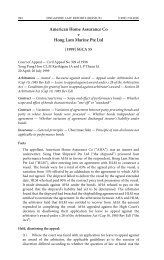
![[1996] 2 SLR(R) 292 - Lim Eng Hock Peter v ... - Singapore Law](https://img.yumpu.com/47482222/1/164x260/1996-2-slrr-292-lim-eng-hock-peter-v-singapore-law.jpg?quality=85)

![[2006] 1 SLR(R) 197 - PT Asuransi Jasa Indonesia - Singapore Law](https://img.yumpu.com/46425352/1/164x260/2006-1-slrr-197-pt-asuransi-jasa-indonesia-singapore-law.jpg?quality=85)
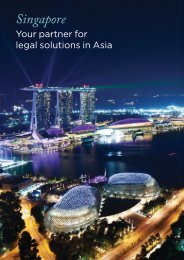
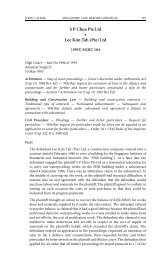
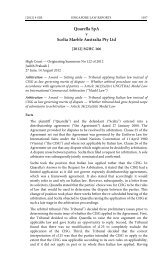
![[2010] 2 SLR 821 - Singapore Law](https://img.yumpu.com/43145563/1/166x260/2010-2-slr-821-singapore-law.jpg?quality=85)
![[2007] 1 SLR(R) 597 - PT Asuransi Jasa Indonesia - Singapore Law](https://img.yumpu.com/42983489/1/164x260/2007-1-slrr-597-pt-asuransi-jasa-indonesia-singapore-law.jpg?quality=85)
![[1989] 1 SLR(R) 433 - Singapore Law](https://img.yumpu.com/42649524/1/164x260/1989-1-slrr-433-singapore-law.jpg?quality=85)
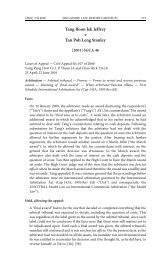
![[1997] 3 SLR(R) 360 - Singapore Law](https://img.yumpu.com/42287507/1/164x260/1997-3-slrr-360-singapore-law.jpg?quality=85)